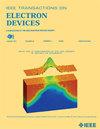Ultrahigh Frequency and Multichannel Output Skyrmion-Based Nano-Oscillator
IF 2.9
2区 工程技术
Q2 ENGINEERING, ELECTRICAL & ELECTRONIC
引用次数: 0
Abstract
Spintronic-based skyrmion nano-oscillators can generate tunable microwave signals that find a wide range of applications in the field of telecommunication to modern neuromorphic computing systems. Skyrmions within a single ferromagnet (FM) material encounter an undesired Magnus force, which imposes limitations on the oscillator’s frequency, typically reaching only a few gigahertz. However, for applications requiring higher data transmission speeds, oscillator frequencies must be elevated to tens of GHz. Conversely, a bilayer device featuring two FM layers coupled in a synthetic anti-ferromagnetic (SAF) configuration can effectively neutralize the Magnus force. Utilizing the bilayer device concept, we propose a multichannel oscillator design, and using micromagnetic simulations, we demonstrate that our proposed device could achieve an ultrahigh frequency of 41 GHz. The ultrahigh operational frequency represents a超高频多通道输出纳米振荡器
基于自旋电子学的斯基米子纳米振荡器可以产生可调谐的微波信号,在电信领域和现代神经形态计算系统中有着广泛的应用。单一铁磁体(FM)材料中的Skyrmions会遇到不希望的马格纳斯力,这对振荡器的频率施加了限制,通常只能达到几兆赫兹。然而,对于需要更高数据传输速度的应用,振荡器频率必须提高到数十GHz。相反,具有两个FM层耦合在合成反铁磁(SAF)结构中的双层器件可以有效地中和Magnus力。利用双层器件的概念,我们提出了一种多通道振荡器设计,并使用微磁模拟,我们证明了我们提出的器件可以实现41 GHz的超高频。超高工作频率比单层单粒子振荡器提高了342倍。我们通过引入多通道纳米轨道和多个skyrmions来增强频率操作,证明了我们提出的多通道振荡器设计的有效性。超高工作频率和多通道输出归因于三个关键因素:1)间隔材料(如Ru)的自旋翻转长度较高,将两个调频层分开;2)切向速度与输入自旋电流成正比,与skyrmins -pair旋转半径的依赖性较弱;3)多通道高各向异性环和skyrmicion - skyrmicion斥力使通道内的skyrmicion互锁。
本文章由计算机程序翻译,如有差异,请以英文原文为准。
求助全文
约1分钟内获得全文
求助全文
来源期刊

IEEE Transactions on Electron Devices
工程技术-工程:电子与电气
CiteScore
5.80
自引率
16.10%
发文量
937
审稿时长
3.8 months
期刊介绍:
IEEE Transactions on Electron Devices publishes original and significant contributions relating to the theory, modeling, design, performance and reliability of electron and ion integrated circuit devices and interconnects, involving insulators, metals, organic materials, micro-plasmas, semiconductors, quantum-effect structures, vacuum devices, and emerging materials with applications in bioelectronics, biomedical electronics, computation, communications, displays, microelectromechanics, imaging, micro-actuators, nanoelectronics, optoelectronics, photovoltaics, power ICs and micro-sensors. Tutorial and review papers on these subjects are also published and occasional special issues appear to present a collection of papers which treat particular areas in more depth and breadth.
 求助内容:
求助内容: 应助结果提醒方式:
应助结果提醒方式:


